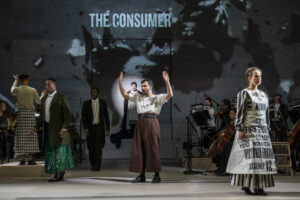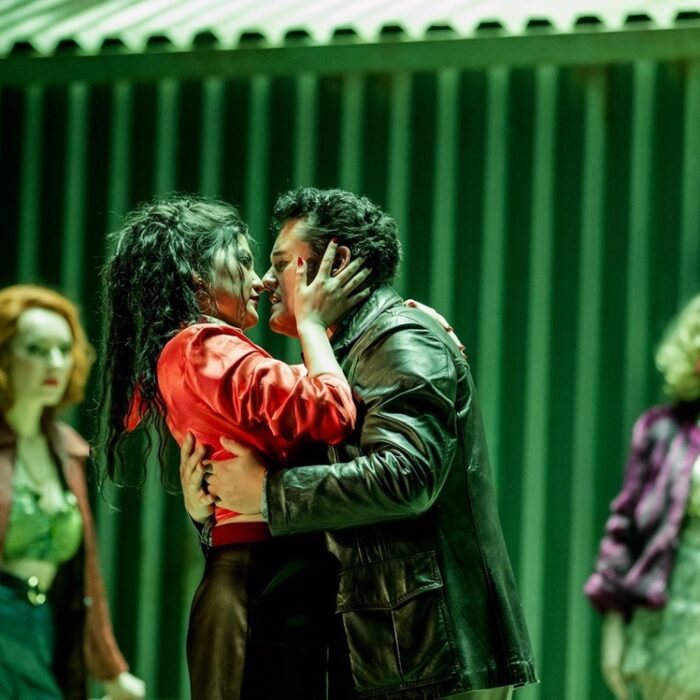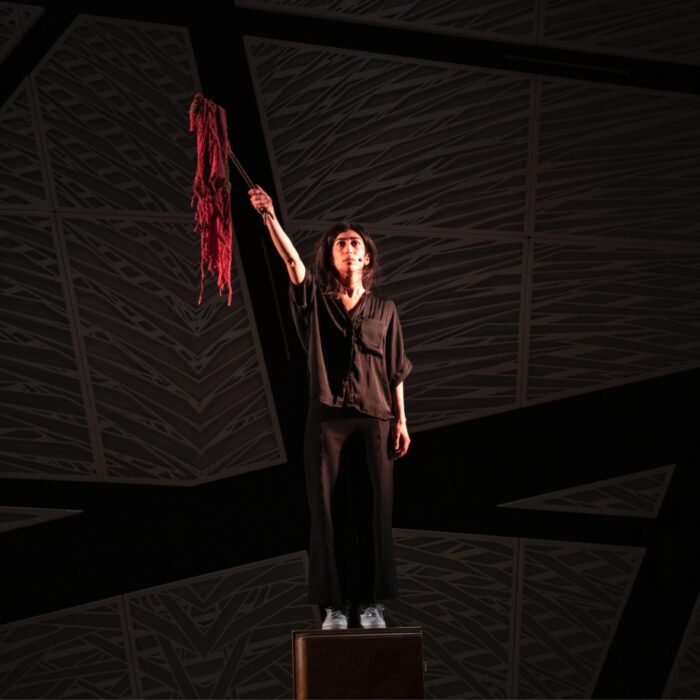
Opera Forward Festival 2024 Review: The Shell Trial
Reid & Perkins Puts The Shell Oil Company Into The Dock Over Its Carbon Emissions
By Alan Neilson(Photo: Marco Borggreve)
In 2021, a court in The Hague ordered the giant oil company Shell to cut its CO2 emissions by 45% by 2030 relative to its 2019 levels. The case had been brought by Dutch environmental groups concerned by the company’s flagrant disregard for the damage their emissions were doing to the planet’s climate; recent research has shown that only six companies worldwide have emitted higher levels of the gas since 1965. Naturally, the company has appealed against the ruling and has so far made no movement towards meeting the court-imposed target. Just a couple of weeks before the appeal hearing was due to take place, Amsterdam’s Opera Forward Festival premiered a new opera written by the composer Ellen Reid and librettist Roxie Perkins based on this case, called “The Shell Trial.”
Who is Responsible for Carbon Emissions?
Their starting point was the play of the same name written by Anoek Nuyens and Rebekka de Wit in 2020. The authors undertook detailed research, listening carefully to all the voices in the debate. They attended shareholder meetings, read speeches, government documents and interviews by the main players – in fact, anything they could find that was relevant. They noted all the arguments and justifications for each person’s actions or non-actions. They discovered that Shell had opened a department to consider future scenarios in which this situation of court action had been considered. They concluded that the “climate crisis was a crisis of responsibility.” No one is prepared to accept responsibility for what is happening. Their play created a forum in which all the voices outlined their stances.
Perkins and Reid built on the play with a work that uses the forms uniquely available to opera to present the narrative in a way impossible in spoken drama through the use of multiple and overlapping voices, set musical pieces, choruses, orchestral commentary, and the spoken word. The result was a collage of voices and sounds that surged and relaxed in response to the arguments, justifications and accusations made by the various parties, set against the background of the fast-advancing climate crisis. Sometimes they raged at each other; sometimes they sympathized with their situations and confronted the audience for its part in the impending disaster. They took solace in their false hopes, despaired as the veil of delusion fell from their eyes and erupted in anger as feelings of hopelessness and powerlessness overwhelmed them. The clash of perspectives gave rise to a swirling, unstable picture of the problem, in which any sense of personal responsibility disappeared, taking with it the possibility of any solutions. It was also a vision that communicated itself clearly to the audience, but without bringing with it a sense of how to move forward or how to deal with the causes of climate change and its consequences.
In Act three, however, Reid and Perkins attempted a possible solution. The Artist appeared and opened up the stage to the children from the past, whose lives and lands had been destroyed by Shell, both through blatant theft and violence and through the effects of climate change. They were joined by people from the future, including a future CEO of the corporation who admits that Shell knew all along of the disastrous consequences that would result from their activities, but as he points out, so did everybody. Together, past and future generations confront the audience, demanding they act now, before it is too late. It proved to be an interesting and artistically convincing conclusion to the work as it did not simply offer communication as the way forward, but by presenting the problem over an elongated time period, it drew attention to the fact that the present generations are only a small fraction of humanity, which is intimately connected to the past and to the future; we are all responsible for what happens, and not just for the time in which we live but also for the people yet to be born.
The opera does not possess a structure that flows easily in the form of a continuous narrative but appears to have been restricted by the need to allow each of the participants to voice their perspective, whether that be in the form of a justification or an argument, a demand or a criticism. The piece, at least in Acts one and two, therefore has a stop-start nature, despite Perkins imaginative efforts to add dramatic tension in the form of confrontations or strong emotional responses. The third act took the work in a completely different direction. The introduction of a children’s chorus, which was mixed with the other characters, not only created a very crowded and very busy stage, but the narrative took wing and allowed the imagination of the audience to interact with the behavior and responsibilities of Shell across time, rather than simply the here and now; of how past generations not only suffered but may have viewed what Shell was doing at the time; and of how future generations may not simply reap the whirlwind that is being created now, but how they may view Shell and our behavior for not taking responsibility.
Reid’s Accomplished Score
Reid’s score was a mixture of atmospheric and accessible melodies in number form. Each of the main characters had an aria or a duet to sing, and in Act three, there were a number of impressive choral pieces. Although it was easy to become distracted from the music, simply because the text was so important in gaining a meaningful understanding of the work, it was emotionally absorbing and interesting. Reid‘s melodies displayed a wide variety of rhythmic variation with lively contrasts that encouraged very dark, depressing and uncomfortable responses, although lighter, softer sections were not completely absent. It was also a score that never stayed too long in the same place; it was always on the move and gave individual sections the opportunity to emerge. Her handling of the set numbers, particularly the choral scenes, was handled well.
The musical director, Manoj Kamps, produced a fine reading from the members of the Concertgebouworkest, bringing out the work’s emotional depths and strength.
A Cluttered Staging Although Not Without Merit
The staging of the work was not wholly satisfactory. The decision to have the orchestra seated on the stage often led to scenes being cluttered and sometimes confusing as characters became lost in the large numbers of singers and musicians. The Consumer, for example, was positioned on a treadmill near the back and one side of the stage. It was a neatly conceived image, but one that would have been easily missed by an inattentive audience member. In the third act, it became impossible to follow in detail or make sense of everything that was happening as the orchestra, soloists, dancers and choruses competed for space.
On the other hand, at times during the first and second acts, the work occasionally became dramatically slow and static, which, given the subject matter of the piece and the need to focus on the words of each of the parties involved in the debate, was almost inevitable. The directors, Romy Roelofsen and Gable Roelofsen, nevertheless managed to keep a pleasing forward momentum and imaginatively introduced each of the participants. They employed numerous subtle touches that added to the understanding, such as having The Government and The CEO stand above the characters in an alcove, looking down on the population below, covered in ice, and frozen out of the debate, either through choice or due to their inability to engage.
With the orchestra seated on the stage, the scope for scenery and props was limited. However, Davy van Gerven’s sets, although simple, were functional and successfully created a pleasing background against which the drama played out. He was aided by Jean Kalman’s energetic and imaginative lighting and Wies Hermans’ abstract, disturbing video compositions. Greta Jones and Flora Kruppa’s costume designs were colorful and generally intended to reflect the position of each character’s position, although with an artistic flourish. Even one or two members of the orchestra were dressed in imaginatively conceived costumes. The overall visual effect was colorful and lively, occasionally even deliberately chaotic.
The decision to keep the auditorium lights on throughout the performance turned out, on reflection, to be a good choice; after all, the audience is as much involved in this conversation as each of the participants. There was no need to hide them.
Twelve Voices Appeal Their Innocence?
There were 12 soloists, all with clearly defined roles, and all with their own views on Shell’s behavior, their own behavior, the effects of climate change and the effect of the court case on their own lives. In Act one, the characters representing the main institutional players make their cases, while in Act two, the narrative shifts to the individuals, people without the power to dictate events: The Teacher, The Activist, The Pilot and so forth. All are given space, either individually or as part of a duet, to voice their concerns.
Soprano Lauren Michelle, cast as The Law, produced an expressively forceful performance in which she explains that the law is not to blame, for it only acts as a mirror to society. Michelle also played the part of the Artist and produced one of the opera’s most powerful arias, “What are we going to say?” in which she gives voice to her own negligence.
Shell’s CEO was given an equally forceful presentation by baritone Audun Iversen. Relaxed and smugly assured, he cast the responsibility back upon the people, asking, “Does Shell’s loss make you fly less,” along with other reasonable questions, which most people do not care to think about.
Mezzo-soprano Claire Barnett-Jones adopted a number of poses aimed at deflecting the blame and bringing the population on side. She was assertive, pleading and reassuring as she explained that the government cannot act too quickly on such matters as it is the poorest who will suffer. At times even appeared to feel a little sorry for herself. It was nuanced theatrical performance, as one would expect from most governments.
Tenor Antony León showed off his resonant, versatile voice with an energetic and animated portrait of The Consumer, trotting out all the reasons as to why climate change was not his responsibility. He had to heat his house, cook food and buy consumer durables, which he felt under so much pressure to do so because of all the advertising, moaning “I am not a bad person,” before questioning if it was all his fault.
The Activist arrived on stage, her words blaring out from a megaphone. The soprano Ella Taylor was totally absorbed in the role. In what was a fine performance, she moulded and held the vocal line well as she raged to the point of near hysteria.
The Fossil Fuel Laborer, played by bass Allan Michael Jones, and The Pilot, played by baritone Alexandre de Jong, both have a lot to lose from any action taken to reduce climate change. They worried about their jobs in a duet, “Who cares?” asking why they should suffer as the CEO of Shell certainly will not be.
Alto Jasmin White produced an excellent performance as The Historian, who refuses to let go of her responsibilities; she knows the past too well. She possesses a wonderfully colorful, expressive and articulate voice, which she used expertly to ram home the atrocities caused by Shell.
The Climate Refugee, played by mezzo-soprano Carla Nahadi Babelegoto, stresses “This is not a part I want to play,” as she describes the situation in which she finds herself, while The Field Worker, essayed by bass-baritone Yannis Francois, showed his anger and frustration to good effect as he complains about the quality of the soil and the crops that are burning.
Soprano Nikki Treurniet, as The School Teacher, was full of anxiety and desperation as she looked at what the future held in store for her children. Tenor Erik Slik gave a strident, bitter and angry performance as The Weatherman.
The combined choruses of the North Holland Selection Choir, The Shell Trial Project Choir and the Children Choir of the Waterland Music School produced a strong, energetic performance. The children, in particular, were very good, not just in their singing but in the way they engaged with their roles.
Lasting approximately 1 hour 45 minutes, “The Shell Trial” is an ambitious work that attempts to answer a question about where responsibility lies in the ongoing debate on climate change and carbon emissions. Reid and Perkins certainly point fingers at certain parties, notably Shell itself, but ask questions of us all and about the responsibility we are taking. They also cleverly put it into a temporal context that starts before our lifetimes and extends beyond them, which powerfully highlighted that we, the present inhabitants of the planet, are but one concern of a wider picture and that we do have responsibility for those who come after us.
It is not, and one would not reasonably expect it to be, a full analysis of all the factors that have led us to our present position with regard to climate change. It has nothing to say, for example, about the fundamental underlying driver, which is that our world is limited in resources and humans are acquisitive by nature and have a drive to provide for themselves, even at the expense of future generations. It nevertheless drew attention to a very important part of the discussion.
As an artwork, this is a worthwhile piece with much to commend outside its political, economic and environmental context. Although the occasional scene, especially in the first two acts, lacks a little dramatic strength, the work as a whole fits together well, and Act three was excellent, both musically and as an illustration of how art can communicate beyond the rational and open up a perspective that words alone cannot.



